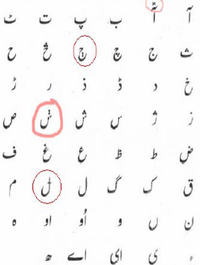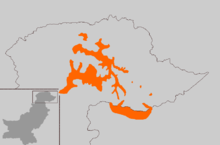Shina language
| Shina | |
|---|---|
 | |
| Native to | Pakistan, India |
| Region | Gilgit-Baltistan, Chitral, parts of Kashmir |
Native speakers | (500,000 cited 1981–1998)[1] |
| Arabic script | |
| Language codes | |
| ISO 639-3 |
Either: scl – Shina plk – Kohistani Shina |
| Glottolog |
shin1264 (Shina)[2]kohi1248 (Kohistani Shina)[3] |
 | |
Shina (Urdu: شینا Šīnā) is a language from the Dardic sub-group of the Indo-Aryan languages family spoken by the Shina people, a plurality of the people in Gilgit-Baltistan, Pakistan, formerly known as the Northern Areas of Pakistan.[4] The separate nature of the Dardic languages is still clear, however, from their close relationship with other Indo-Aryan languages, especially Punjabi.[5]
Dialects are Gilgiti (the prestige dialect), Astori, Chilasi Kohistani, Drasi, Gurezi, Jalkoti, Kolai, and Palasi. Related languages spoken by ethnic Shina are Brokskat (the Shina of Baltistan and Ladakh), Domaa, Kohistani Shina, Palula, Savi, and Ushojo. Shina is the language of 40% people of Gilgit Baltistan.The valleys in which it is spoken include Southern Hunza Astore, Chilas, Darel, Tangir, Gilgit, Ghizer, Gurez, Drass, Juglot Valley, Drotte Palas, Kolai, and Kohistan.
Writing
Shina is usually written with a variation of the Urdu alphabet. The additional letters to write Shina are:
- ݜ for /ʂ/
- ڙ for /ʐ/
- څ for /ts/
- ڇ for /ʈʂ/
- ݨ for /ɳ/
The language is also written in Devanagari script as well, using the nuqta dot for additional Shina sounds.
Phonology
Vowels
The Shina principal vowel sounds:[6]
| Front | Mid | Back | ||
|---|---|---|---|---|
| unrounded | rounded | |||
| High | i | u | ||
| Lower high | e | o | ||
| Higher low | ɛ | ə | ʌ | ɔ |
| Low | a | |||
All vowels but /ɔ/ can be either long or nasalized, though no minimal pairs with the contrast are found.[6]
Diphthongs
In Shina there are the following diphthongs:[7]
- falling: ae̯, ao̯, eə̯, ɛi̯, ɛːi̯, ue̯, ui̯, oi̯, oə̯;
- falling nasalized: ãi̯, ẽi̯, ũi̯, ĩũ̯, ʌĩ̯;
- raising: u̯i, u̯e, a̯a, u̯u.
Consonants
| Labial | Coronal | Retroflex | Palatal | Velar | Glottal | ||
|---|---|---|---|---|---|---|---|
| Stop | Plain | p | t | ʈ | k | ||
| Aspirated | pʰ | tʰ | ʈʰ | kʰ | |||
| Voiced | b | d | ɖ | ɡ | |||
| Affricate | Plain | ts | tʂ | tʃ | |||
| Aspirated | tsʰ | tʂʰ | tʃʰ | ||||
| Voiced | dz[lower-alpha 1] | dʒ[lower-alpha 1] | |||||
| Fricative | Plain | (f) | s | ʂ | ʃ | x[lower-alpha 1] | h |
| Voiced | z | ʐ | ʒ[lower-alpha 1] | ɣ[lower-alpha 1] | ɦ[lower-alpha 1] | ||
| Nasal | m | n | s | ŋ | |||
| Lateral | l | ||||||
| Rhotic | r | ɽ[lower-alpha 2] | |||||
| Semivowel | ʋ~w | j | |||||
Tone
Shina has three contrasting tones: level, rising, and falling tones.
Example: 1.the............2.thée.........3.theé 1. The first example "the" has a level tone and is translated by the imperative "Do". 2. When the stress falls on the first mora of a long vowel, the tone is falling. Thus the second example means "Will you do?". 3. When the stress falls on the second mora of a long vowel, the tone is rising. Thus the third example means "After having done". There are many minimal pairs in Shina to prove that it contains three tones.
See also
Notes
- ↑ Shina at Ethnologue (18th ed., 2015)
Kohistani Shina at Ethnologue (18th ed., 2015) - ↑ Hammarström, Harald; Forkel, Robert; Haspelmath, Martin; Bank, Sebastian, eds. (2016). "Shina". Glottolog 2.7. Jena: Max Planck Institute for the Science of Human History.
- ↑ Hammarström, Harald; Forkel, Robert; Haspelmath, Martin; Bank, Sebastian, eds. (2016). "Kohistani Shina". Glottolog 2.7. Jena: Max Planck Institute for the Science of Human History.
- ↑ "Mosaic Of Jammu and Kashmir".
- ↑ http://www.iranicaonline.org/articles/dardestan-
- 1 2 Rajapurohit 2012, p. 28–31.
- ↑ Rajapurohit 2012, p. 32–33.
References
- Calvin R. Rensch, Sandra J. Decker, Daniel G. Hallberg. (1992). Languages of Kohistan (Sociolinguistic Survey of Northern Pakistan, 1). National Institute of Pakistani Studies, 263 pp. ISBN 969-8023-11-9.
- Backstrom, Peter C. (1992). Languages of Northern Areas (Sociolinguistic Survey of Northern Pakistan, 2). 417 pp. ISBN 969-8023-12-7.
- Degener, Almuth. (2008). Shina-Texte aus Gilgit (Nord-Pakistan): Sprichwörter und Materialien zum Volksglauben, gesammelt von Mohammad Amin Zia. Wiesbaden: Harrassowitz Verlag. Contains a Shina grammar, German-Shina and Shina-German dictionaries, and over 700 Shina proverbs and short texts.
- Rajapurohit, B. B. (2012). Grammar of Shina Language and Vocabulary (PDF).
- Zia, Muhammad Amin. (1986). Shina Grammar. First Shina grammar to be written in Shina.
- Zia, Muhammad Amin. Shina Lughat (Shina Dictionary). First available Shina dictionary, containing 15000 words plus material on the phonetics of Shina.
- Zia Muhammad Amin. Bayaak (Meeting Place) Shina Radio Features, translation and inter linear explanation in English by Prof. Dr. Gearg Buddruss and Almuth Degener. Published in Germany
External links
| Shina language test of Wikipedia at Wikimedia Incubator |